News
2013 MIT Lincoln Laboratory Technical Awards recognize exceptional accomplishments
Jeremy Kepner and Roderick Kunz receive Technical Excellence Awards
On 28 February, the recipients of MIT Lincoln Laboratory's 2013 awards for technical excellence, early career technical achievement, best paper, and best invention were honored at a ceremony held in the Laboratory's auditorium and attended by more than 300 colleagues, family members, and friends of the honorees.
Dr. Jeremy Kepner, senior staff member in the Computing and Analytics Group, and Dr. Roderick R. Kunz, assistant leader of the Chemical, Microsystem, and Nanoscale Technologies Group, were presented with Technical Excellence Awards, which recognize "exceptional, sustained, technical work that has made a significant impact on a Laboratory mission area."
Jeremy Kepner
Dr. Kepner was recognized for "his leadership and vision in bringing supercomputing to Lincoln Laboratory through the establishment of LLGrid; his pivotal role in open systems for embedded computing; his creativity in developing a novel database management language and schema; and his contributions to the field of graph analytics."
 Dr. Jeremy Kepner (center) was presented a 2013 Technical Excellence Award by MIT Lincoln Laboratory Director, Dr. Eric Evans (left) and was introduced at the ceremony by David Martinez (right), associate head of the Cyber Systems and Information Sciences Division. Dr. Jeremy Kepner (center) was presented a 2013 Technical Excellence Award by MIT Lincoln Laboratory Director, Dr. Eric Evans (left) and was introduced at the ceremony by David Martinez (right), associate head of the Cyber Systems and Information Sciences Division. |
In his 16 years at the Laboratory, Dr. Kepner has worked on various high-performance embedded computing projects. He led the Department of Defense (DoD) High Performance Embedded Computing Software Initiative that created the Vector, Signal, and Image Processing Library standard used in many DoD sensor systems, and directed the development of the Parallel Vector Tile Optimizing Library, which earned a 2011 R&D 100 Award. He invented MatlabMPI software and pMatlab (Parallel Matlab Toolbox) used by 10,000s of scientists and engineers worldwide. This software became the foundation of the Lincoln Laboratory Grid (LLGrid) program that provides supercomputing capabilities to the entire Laboratory.
Dr. Kepner led the Defense Advanced Research Projects Agency's (DARPA) High Productivity Computing Systems team that developed the benchmarks used to validate most supercomputers today. More recently, he patented the Dynamic Distributed Dimensional Data Model, a database management system widely used in government big data systems and Lincoln Laboratory's big data efforts. A research affiliate of the MIT Computer Science and Artificial Intelligence Laboratory and the MIT Mathematics Department, he has authored or coauthored numerous publications and two books, and has served as the technical chair of the IEEE High Performance Extreme Computing Conference.
Roderick Kunz
Dr. Kunz was honored for "his outstanding technical contributions to the team that developed the 193-nm lithography process for integrated circuit device fabrication, and for subsequent advancements in lithography, such as the world's first photolithography exposure tool and procedures for improving the durability of 193-nm lenses."
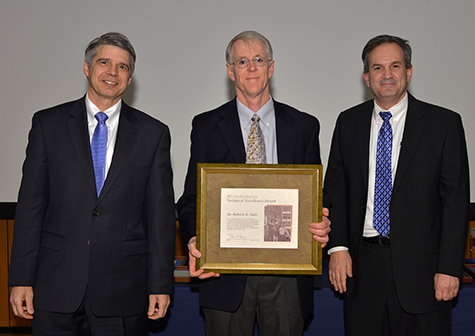 Dr. Roderick Kunz (center) was presented a 2013 Technical Excellence Award by MIT Lincoln Laboratory Director, Dr. Eric Evans (left) and was introduced by Dr. Craig Keast (right), associate head of the Advanced Technology Division. Dr. Roderick Kunz (center) was presented a 2013 Technical Excellence Award by MIT Lincoln Laboratory Director, Dr. Eric Evans (left) and was introduced by Dr. Craig Keast (right), associate head of the Advanced Technology Division. |
As a technical staff member in the former Submicrometer Technology Group, Dr. Kunz worked on a team whose research focus was to extend semiconductor lithography to wavelengths below 200 nm. His work with industry in the areas of optics, photoresist, and pellicle development, testing, and characterization contributed to the development and worldwide adoption of 193-nm lithography for critical-level integrated-circuit device fabrication, and led to his authorship or coauthorship of more than 60 papers, six patents, and numerous invited presentations and short courses delivered at international conferences.
In 1998, Dr. Kunz initiated and directed an effort to assess and mitigate serious lens photocontamination issues hampering the adoption of 193- and 248-nm large-volume photolithography. He designed and built a specialized test bed that became the worldwide industry-standard method of assessing photocontamination, a capability that led to the establishment of specifications adopted by the Semiconductor Industry Association and used to this day. More recently, Dr. Kunz has turned his attention to the understanding and development of explosives detection, an activity that prompted the creation of the nationally respected chemical forensics and advanced mass spectrometry facility at Lincoln Laboratory. Subsequently, he has been invited to participate in several explosives-detection working groups and task forces.
Early Career Technical Achievement
The 2103 Early Career Technical Achievement Awards were presented to Dr. Brooke E. Shrader, a technical staff member in the Wideband Tactical Networking Group, and Scott Van Broekhoven, assistant leader of the Rapid Prototyping Group. Dr. Shrader was recognized for her work as the primary developer of a new class of network protocols that mitigate channel impairments commonly encountered by mobile communication networks. She has applied the theory of network coding to develop a protocol capable of exploiting the inherent link diversity in heterogeneous tactical networks.
Mr. Van Broekhoven was recognized for his technical expertise, leadership skills, initiative, and innovative thinking as the Engineering Division's lead engineer in work on advanced energy systems and miniature unmanned aerial vehicles. His ability to direct the execution of major design and test projects was seen in his management of the mechanical design, analysis, and test efforts for programs under which advanced hardware and sensor subsystems were developed.
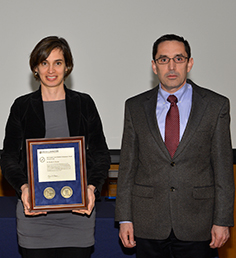 |
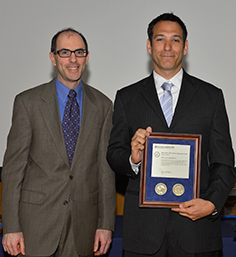 |
| Early Career Technical Achievement Awards for 2013 were presented to Dr. Brooke Shrader (left, left photo) by Carl Fossa (right), assistant leader of the Wideband Tactical Networking Group, and to Scott Van Broekhoven (right, right photo) by Dr. Eliahu Niewood (left), head of the Engineering Division. |
|
Best Paper and Best Invention
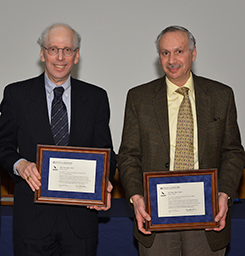 Jeffrey Shapiro, the Julius A. Stratton Professor of Electrical Engineering, MIT (left), and Dr. Ronald R. Parenti, a technical staff member in the Advanced Lasercom Systems and Operations Group, were recipients of the 2013 MIT Lincoln Laboratory Best Paper Award. They and coauthor Dr. Andrew L. Puryear, who could not attend the ceremony, received this award for the article "Reciprocity-Enhanced Optical Communication Through Atmospheric Turbulence—Part I: Reciprocity Proofs and Far-Field Power Transfer Optimization and Part II: Communication Architectures and Performance." The papers were published in December 2012 and August 2013 in the IEEE/OSA Journal of Optical Communications and Networking. The paper was selected for its development of a rigorous, reciprocity-based framework to improve optical communication through turbulence.
Jeffrey Shapiro, the Julius A. Stratton Professor of Electrical Engineering, MIT (left), and Dr. Ronald R. Parenti, a technical staff member in the Advanced Lasercom Systems and Operations Group, were recipients of the 2013 MIT Lincoln Laboratory Best Paper Award. They and coauthor Dr. Andrew L. Puryear, who could not attend the ceremony, received this award for the article "Reciprocity-Enhanced Optical Communication Through Atmospheric Turbulence—Part I: Reciprocity Proofs and Far-Field Power Transfer Optimization and Part II: Communication Architectures and Performance." The papers were published in December 2012 and August 2013 in the IEEE/OSA Journal of Optical Communications and Networking. The paper was selected for its development of a rigorous, reciprocity-based framework to improve optical communication through turbulence.
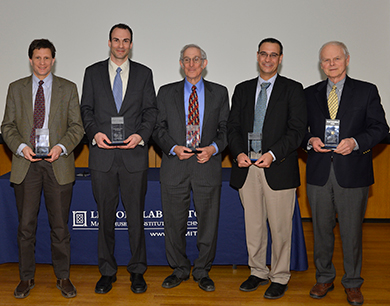 |
|
| The 2013 MIT Lincoln Laboratory Best Invention trophies were awarded to (left to right) Lawrence M. Candell, Curtis B. Colonero, Dr. Robert Berger, Dr. Michael W. Kelly, and Dr. Daniel L. Mooney. The team developed the Digital Readout Method and Apparatus (better known as the Digital-Pixel Focal Plane Array). This revolutionary technology enables reading out an imaging focal plane by employing advances that allow the signal levels at each detector to be digitized at the pixel level.
|
Lincoln Laboratory established the Technical Excellence Awards in 2001 to recognize exceptional individual technical accomplishments in support of a Laboratory mission area. The Best Paper and Best Invention Awards were introduced in 2009, and the Early Career Technical Achievement Awards were instituted in 2010.
Posted April 2014
top of page